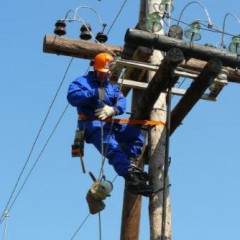What is phase rotation and how to check it?
Small introduction
The story of the installation of electrical equipment, namely two oil transformers, caught my eye. The work was completed successfully. As a result, there was the following power supply scheme. Actually the transformers themselves, opening switches, section disconnectors, two bus sections. Successfully, as the installers believed, commissioning was completed. They began to turn on both transformers for parallel operation and got short circuit. Naturally, the installers claimed that they had checked the phase rotation from both sources and everything coincided. But, not a word was said about phasing. But in vain! Now let's look in detail what went wrong.
What is phase rotation?
As you know, in a three-phase network there are three opposite phases. Conventionally, they are designated as A, B and C. Remembering the theory, we can say that the sinusoids of the phases are displaced relative to each other by 120 degrees. So there can be six different alternating orders, and they are all divided into two types - direct and reverse. Direct alternation is considered to be the following order - ABC, ICA and CAB. The reverse order will be respectively CBA, BAC and DIA.
To check the phase sequence, you can use a device such as a phase indicator. About, how to use a phase indicator, we already told. Specifically, we consider the sequence of checks with the FU 2 device.
How to check?
The device itself (provided in the photo below) consists of three windings and a disk that rotates during verification. Black marks are applied on it, which alternate with white. This is done for easy reading of the result. The device works on the principle of an induction motor.
So, we connect three wires from a three-phase voltage source to the terminals of the device. Press the button on the device, which is located on the side wall. We will see that the disk began to rotate. If it rotates in the direction of the arrow drawn on the device, it means that the phase rotation is direct and corresponds to one of the variants of the order of ABC, ICA or CAB. When the disk rotates in the opposite direction to the arrow, we can talk about reverse rotation. In this case, one of these three options is possible - CBA, BAC or DIA.
If you go back to the story with the installers, then all they did is just determine the phase sequence. Yes, in both cases the order is the same. However, it was still necessary to check the phasing.And it can not be done using a phase indicator. When turned on, opposite phases were connected. To find out where conditionally A, B and C, it was necessary to use a multimeter or oscilloscope.
A multimeter measures the voltage between the phases of different power sources and if it is zero, then the phases of the same name. If the voltage corresponds to the linear voltage, then they are opposite. This is the easiest and most effective way. More about how to use a multimeter, you can find out in our article. You can, of course, use an oscilloscope and look at the waveform which phase is 120 degrees behind which, but this is not practical. Firstly, the procedure is complicated by an order of magnitude, and secondly, such a device costs a lot of money.
The video below clearly shows how to check the phase rotation:
When should order be considered?
Check the phase rotation is necessary when operating three-phase AC motors. The direction of rotation of the engine will change from the order of the phases, which is sometimes very important, especially if there are many mechanisms using engines on the site.
It is also important to take into account the phase sequence when connecting the CA4 induction type electric meter. If the order is reversed, a phenomenon such as spontaneous movement of the disk on the counter is possible. New electronic meters, of course, are insensitive to phase rotation, but the corresponding image will appear on their indicator.
If there is an electric power cable with which you need to connect a three-phase power supply, and you need phasing control, you can perform it without special devices. Often the cores inside the cable differ in the color of the insulation, which greatly simplifies the "dialing" process. So, to find out where phase A, B or C is conditionally located, you only need remove the outer insulation of the cable. At both ends we will see veins of the same color. We will take them for the same. Read more about color coded wires You can find out from our article.
But nevertheless one cannot blindly trust such a marking. So, in practice, there are times that cable manufacturers cannot guarantee that at the beginning and at the end of the cable the core color will be the same. Therefore, you still need to ring the veins with a bell.
Now you know what phase rotation is in a three-phase network and how to check it using instruments. We hope the information was useful and interesting for you!
We also recommend that you read:










